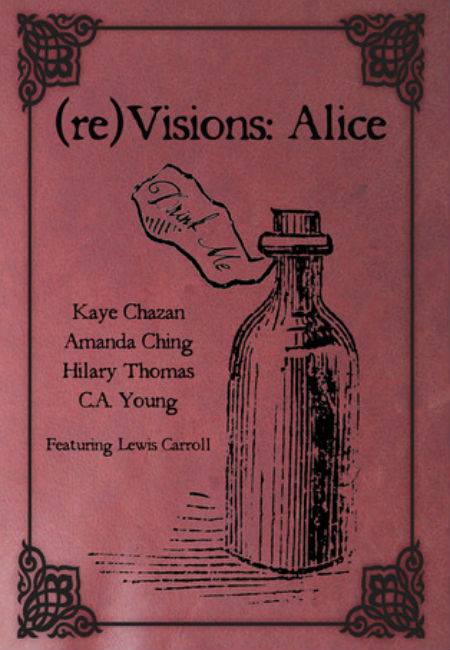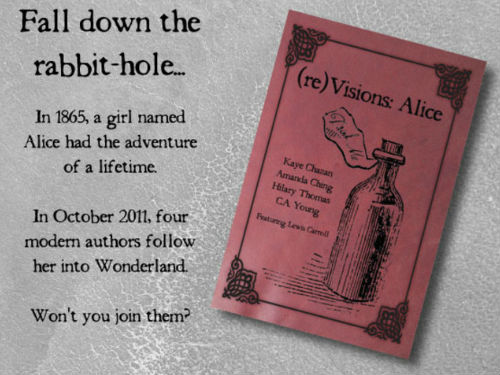
This is the third in a series of interviews with the (re)Visions: Alice that I published on a now sadly defunct writing site back in 2012. I hope you enjoy discovering more about the authors behind these remarkably imaginative re-imagined tales.
The publication of Hilary Thomas’s evocative novelette “Knave” in the (re)Visions: Alice collection represents this talented writer’s publishing debut with her work up to this point being primarily script-based.
But given the warm reception to her Film Noir-influenced tale, where Lewis Carroll’s characters play members of Wonderland’s criminal underworld, we doubt this will be the last we hear of her.
“Knave” focuses on Jack Knave, head of the Queen’s security apparatus who learns in the course of investigating a crime just how precarious anyone’s position is when you work for such a hot-headed member of royalty.
Hilary confesses that while she wasn’t a fan of the classic prior to writing the short story, she now has a new found appreciation for Alice, The Queen, and the panoply of oddball characters that populate Carroll’s imaginative tale.
I talked with her about the challenge inherent in paying homage to a story this loved and revered, and whether this might lead to further excursions into the world of prose in the future.
(1) What have you written prior to this and how did you come to be involved in the (re)Visions: Alice project? Was it a natural fit for you as a writer?
Kate approached me with the concept of the (re)Visions series several years ago, and I was hooked from the start. I had mentioned that I was a writer, and the idea of experimenting with such well-loved source material in a transformative way really turned my crank. I’ve been writing fanfiction for years, so I feel like it was a natural fit for me in a lot of ways. I love playing around in other people’s universes. As to works I’ve written prior to this, (re)Visions: Alice is actually my publishing debut! Mostly, I do script adaptations for a variety of animation and live-action film and television properties.
(2) How hard was it to pay homage to such a well-loved book as Alice in Wonderland in your contributed story without losing your own voice, especially since it casts such a long shadow over modern fiction?
Alice has been so well-loved, and reinterpreted in so many ways over the years, that working with it was honestly a very daunting prospect. From the start, I knew I wanted to write something really different, something I hadn’t seen before; but between Disney and Tim Burton and Broadway and prime-time television, a lot of ground had already been covered. And Carroll’s work is so unique and fantastical, while simultaneously being a snarky book about mathematics, that I knew I would never be able to match his voice. So I decided I wasn’t even going to try. I started thinking about the math angle in an abstract way, and I remembered the old logic puzzle – Knights tell the truth and Knaves always lie. And hey, there was a Knave right there, being accused of Grand Theft Tart, and what if he got to tell his side of the story? What if he wasn’t the most reliable narrator? After that, hardboiled detective noir seemed like the obvious choice. It was a really fun challenge interpreting the world of Wonderland through such a gritty lens. Emphasis on the challenge!
(3) What is the one fantastical element from Alice in Wonderland that you were most looking forward to introducing into your story and why? Did it come first or did you simply weave it into an existing idea you had?
I didn’t really have one particular fantastical element in mind when I started writing “Knave.” I was focused on the characters first, though many of them are plenty fantastical! I had a lot of fun translating their personalities and skill sets into things that fit the criminal underworld of my Wonderland. The Cheshire Cat’s cryptic disappearing act, especially. I did have an image in mind, and it’s pretty silly, but I’ve always been really taken with the idea of Alice attempting to play croquet with a temperamental flamingo. I wasn’t consciously looking for a way to incorporate that into “Knave”, because I honestly didn’t think there was a place for it, but it completely blindsided me on the way home one night. Of course, Flamingo is a make of handgun, probably with pink mother-of-pearl grips, and you should be careful, because she bites. I laughed out loud, and the people on the train started edging away from me like I was a madwoman. Which may be fair enough, actually!

(4) Was Alice in Wonderland an inspiration for you prior to being involved in this project or did you really only come to appreciate its worth once you started writing your story for (re)Visions: Alice?
In the interests of full disclosure, I have to confess – I never really liked Alice in Wonderland. I know, I’m terrible. While I’ve always loved the world, and all the fascinating characters who inhabit Wonderland, I’ve never had any patience for Alice herself. We’ve never had a common viewpoint, not even when I was a kid, and I always felt like she could have done a lot more with her time in Wonderland. But there were enough things about the story that I’ve always loved, the Cheshire Cat, the Mad Hatter and the March Hare, the Queen of Hearts and her cards, the Gryphon and the Mock Turtle, the clever wordplay and vivid imagery (I could go all day!), that I didn’t hesitate at all to take the (re)Visions: Alice project on. In fact, I was really eager for the challenge! And I have to say, after writing “Knave,” I have a completely new and different appreciation for the story.
(5) What is your preferred writing style? Pantser or plotter? How did that work with a unique project such as this?
I don’t really have a consistent writing “style,” really. When it comes to creative writing, I usually start with an image, or a concept I’m curious about, and just start playing with it; seeing how it spins out, where it goes. Often this raises further questions, and by exploring those I come up with a loose framework for a story. Sometimes I even follow it. Once I had the original concept for “Knave,” I knew I wanted to tell a story parallel to Alice’s POV in Wonderland, something in which her actions had consequences, and in which she was the focus. So I read through Carroll’s text several times, taking detailed notes and text citations, and I drew out a timeline of her action through the story. Then I looked for the places it crossed with the Knave in canon, and the places I could make it cross, and that was my guideline. Once I had the guidelines, I found I still had a lot of freedom to play around. So it was different from my usual process, but I feel like it worked really well.
(6) What does the future hold for you? Similar themed projects or do you plan to take a dramatic leap to another genre entirely?
I’ve actually been working on an original script for a feature length animated screenplay, but it’s still in talks and the whole thing is so nebulous that I hesitate to even mention it. But if that does work out, it’ll be quite the departure from the tone and style of “Knave”! I’ve also started work on a novel, which is very daunting as I’m pretty firmly a short format gal, but I’m looking forward to the challenge. It’s a sort of vaguely noirpunk thing about a mercenary. We’ll see how it goes. I have been playing with a few stories set in my urban Wonderland, for characters other than Jack and Alice, but I honestly have no idea if anyone but me will ever see them. I just have a hard time letting go, sometimes, and there are so many stories I didn’t get to tell in “Knave.” I hope to be involved in another (re)Visions project somewhere down the line, because this was a wonderful experience from beginning to end, even when it was challenging and fraught with peril. And working with Kate is an absolute pleasure!
*”Knave” represents Hilary Thomas’s publishing debut. But it’s doubtful this is the last you will hear of this talented writer who is eager to stay in Lewis Carroll’s magical world a while longer and see where it takes her.